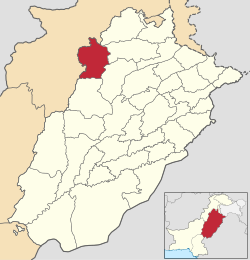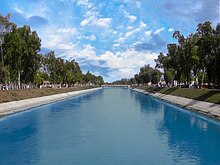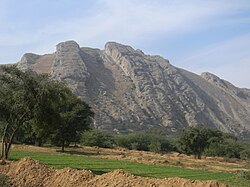
A | B | C | D | E | F | G | H | CH | I | J | K | L | M | N | O | P | Q | R | S | T | U | V | W | X | Y | Z | 0 | 1 | 2 | 3 | 4 | 5 | 6 | 7 | 8 | 9
Mianwali
ضِلع مِيانوالی | |
|---|---|
 Mianwali District highlighted within Punjab Province | |
| Country | |
| Province | |
| Division | Mianwali Division |
| Headquarters | Mianwali |
| Government | |
| • Type | District Administration |
| • Deputy Commissioner | Sajjad Ahmad[1] |
| • District Police Officer | N/A |
| • District Health Officer | N/A |
| Area | |
| • Total | 5,840 km2 (2,250 sq mi) |
| Population | |
| • Total | 1,798,268 |
| • Density | 310/km2 (800/sq mi) |
| Time zone | UTC+5 (PST) |
| Postal Code | 42200 |
| Area code | 0459 |
| Number of Tehsils | 3 |
| Website | mianwali |

The Mianwali District (Urdu: ضِلع مِيانوالى) is a district located in the Mianwali division of the Punjab province of Pakistan.
It has borders with the Chakwal, Attock, Kohat,[4] Karak, Lakki Marwat, Dera Ismail Khan, Bhakkar,[5] and Khushab districts.
History
The history of the district is tied to the Miana family which came from Baghdad and settled in Mianwali. The name Mianwali is derived from a sufi saint Mian Ali's name. Mian Ali Mianwali was a known settlement and an agricultural region with forests during the Indus Valley Civilization (c. 3300 – c.1300 BCE). Mianwali later became part of the Vedic civilization.
After the conquest of Punjab, Arabs who had established themselves in Multan were in control of Mianwali and surrounding areas of Punjab.[6]
In 997 CE, Sultan Mahmud Ghaznavi took over the Ghaznavid empire established by his father, Sultan Sebuktegin. In 1005 CE, he conquered the Hindu Shahis and followed it by the conquests of the Punjab region. The Delhi Sultanate and later Mughal empire ruled the region. The population of the Punjab region became majority Muslim, following the conquests by various Muslim dynasties from Central Asia.
The real historical representation of the Mianwali region is older than 900 AD but the true accuracy is traced to the arrival of Qutb Shah in 1090 AD who in later years of his conquest allowed his sons to settle and further rule the region.[citation needed] Their lineage still exists to date in the Mianwali district as well as in Pakistan and are known as Awan tribe. Historically, all major rulers of South Asia governed this area in their turn. Mughal emperor Babur mentioned Isakhel in the Baburnama when describing his campaigns against the Malik Awans and Niazi Pakhtuns during his invasion of Punjab in the 1520s.
Prior to the invasion of Nadir Shah in 1738, there is little to relate concerning the history of the northern part of the district. The upper half of the district was ruled by the Gakhars, who became feudatories of the Mughal empire, of which the district continued to form a part until the invasion of Nadir Shah. In 1738, a portion of his army entered Chashma. By its atrocities so cowed the Bannuchis and Marwats that a heavy tribute was raised from them. Another portion of the army crossed the Darra Pezu and worked its way down to Dera Ismail Khan. Contingents raised from the neighborhoods of Bannu and Dera Ismail Khan marched under Nadir Shah's banner to the sack of Delhi.
In 1739, the area west of the Indus was surrendered by the emperor of Delhi to Nadir Shah and passed after his death to Ahmad Shah Abdali. In 1748, a Durrani army under one of Ahmad Shah's generals crossed the Indus at Kalabagh, and drove out the Ghakkars, who still ruled in the cis-Indus tracts of the district, owing nominal allegiance to the emperor at Delhi. Their stronghold, Muazzam Nagar, was razed to the ground, and with their expulsion was swept away the last vestige of the authority of the Mughal emperor in these parts. During the British Raj, the Mianwali district was also among the states of the British Punjab where regional offices of East India Company were in position until winter of 1883 when the regional office of East India Company in Mianwali was shut down due to civil unrest and hostile conditions.[7]
Geography
Mianwali district covers an area of 5,840 square kilometres (2,250 sq mi).[8] The area in the north is a continuation of the Pothohar Plateau[9] and the Kohistan-e-Namak.[10] Southern side of the district is a part of Thal desert.[11] Indus River flows through the district.[12]
Climate
Mianwali district has an extreme climate with a long hot summer season and dry cold winters. Summer lasts from May to September and winter lasts from November till February.[13] June is the hottest month with average temperature of 42 °C (highest recorded temperature was 52 °C); in winter, the average temperature can be as low as 3 to 4 °C, particularly in December and January. The average rainfall in the district is about 385 mm.[14][15]
| Month | Jan | Feb | Mar | Apr | May | Jun | Jul | Aug | Sep | Oct | Nov | Dec | Year |
|---|---|---|---|---|---|---|---|---|---|---|---|---|---|
| Average High Temperatures °C (°F) | 19° (66.2 °) | 21° (69.8 °) | 26° (78.8 °) | 33° (91.4 °) | 38° (100.4 °) | 42° (107.6 °) | 39° (102.2 °) | 37° (98.6 °) | 37° (98.6 °) | 33° (91.6 °) | 28° (82.4 °) | 21° (69.8 °) | 31° (87.8 °) |
| Average Low Temperatures °C | 3 | 6 | 12 | 17 | 22 | 27 | 27 | 26 | 23 | 16 | 9 | 4 | 16 |
| Rainfall in. (cm) | 1.6 | 2.1 | 4.1 | 2.4 | 1.9 | 1.8 | 7.6 | 11 | 4.5 | 0.7 | 0.1 | 0.9 | 38.5 |
| Source: Weatherbase | |||||||||||||
Administration
The district is administratively divided into three tehsils 7 Municipal Committees and 51 union councils:[16][17]
| Name of tehsils | No. of union councils | No. of municipal committees | Parent tehsil |
|---|---|---|---|
| Isakhel[16] | 13 | 3 | Mianwali |
| Mianwali[16] | 26 | 2 | Mianwali |
| Piplan[16] | 12 | 2 | Mianwali |
| Total | 51 | 7 |
Demographics
Population
| Year | Pop. | ±% p.a. |
|---|---|---|
| 1951 | 315,816 | — |
| 1961 | 413,851 | +2.74% |
| 1972 | 595,134 | +3.36% |
| 1981 | 711,529 | +2.00% |
| 1998 | 1,056,620 | +2.35% |
| 2017 | 1,542,601 | +2.01% |
| 2023 | 1,798,268 | +2.59% |
| Sources:[18] | ||
At the time of the 2017 census, Mianwali district had 237,952 households and a population of 1,546,094.[19] Mianwali had a sex ratio of 998 females per 1000 males and a literacy rate of 61.28% - 78.54% for males and 44.35% for females. 327,812 (21.25%) lived in urban areas. 396,880 (25.73%) were under 10 years of age.[19] In 2023, the district had 296,614 households and a population of 1,798,268.[20]
Religion
As per the 2023 census, Muslims made up almost the entire population with 99.32%, although there is a small mainly urban minority of Christians numbering 11,951.
| Religious group |
1941[21]: 42–43 | 2017 | 2023 | |||||||||
|---|---|---|---|---|---|---|---|---|---|---|---|---|
| Pop. | % | Pop. | % | Pop. | % | |||||||
| Islam |
266,984 | 88.91% | 1,535,345 | 99.53% | 1,783,687 | 99.32% | ||||||
| Hinduism |
30,084 | 10.02% | 21 | 0% | 63 | 0% | ||||||
| Sikhism |
2,869 | 0.96% | — | — | 41 | 0% | ||||||
| Christianity |
302 | 0.1% | 7,044 | 0.46% | 11,951 | 0.67% | ||||||
| Ahmadi | — | — | 101 | 0.01% | 45 | 0% | ||||||
| Others | 47 | 0.02% | 90 | 0.01% | 110 | 0.01% | ||||||
| Total Population | 300,286 | 100% | 1,542,601 | 100% | 1,795,897 | 100% | ||||||
| Note: 1941 figures are for Mianwali and Isakhel tehsils of the then Mianwali District, which roughly corresponds to present-day Mianwali district. | ||||||||||||
| Religious group |
1901[22] | 1911[23][24] | 1921[25] | 1931[26] | 1941[27] | |||||
|---|---|---|---|---|---|---|---|---|---|---|
| Pop. | % | Pop. | % | Pop. | % | Pop. | % | Pop. | % | |
| Islam |
371,674 | 87.54% | 299,971 | 87.87% | 308,876 | 86.23% | 357,109 | 86.77% | 436,260 | 86.16% |
| Hinduism |
50,202 | 11.82% | 36,326 | 10.64% | 45,974 | 12.83% | 49,794 | 12.1% | 62,814 | 12.41% |
| Sikhism |
2,633 | 0.62% | 4,881 | 1.43% | 2,986 | 0.83% | 4,231 | 1.03% | 6,865 | 1.36% |
| Christianity |
44 | 0.01% | 168 | 0.05% | 369 | 0.1% | 380 | 0.09% | 358 | 0.07% |
| Jainism |
35 | 0.01% | 31 | 0.01% | 0 | 0% | 20 | 0% | 23 | 0% |
| Zoroastrianism |
0 | 0% | 0 | 0% | 0 | 0% | 5 | 0% | 1 | 0% |
| Buddhism |
0 | 0% | 0 | 0% | 0 | 0% | 0 | 0% | 0 | 0% |
| Judaism |
0 | 0% | 0 | 0% | 0 | 0% | 0 | 0% | 0 | 0% |
| Others | 0 | 0% | 0 | 0% | 0 | 0% | 0 | 0% | 0 | 0% |
| Total population | 424,588 | 100% | 341,377 | 100% | 358,205 | 100% | 411,539 | 100% | 506,321 | 100% |
| Note: British Punjab province era district borders are not an exact match in the present-day due to various bifurcations to district borders — which since created new districts — throughout the historic Punjab Province region during the post-independence era that have taken into account population increases. | ||||||||||
Language
At the time of the 2023 census, 73.69% of the population spoke Saraiki language, 11.35% Pashto, 7.79% Punjabi, 3.5% Hindko and 3.15% Urdu as their first language.[28]
People
- Mian Sultan Zikria - Famous sufi saint from the Mianwali district
- Amjad Khan Niazi - Retired Chief of Naval Staff of Pakistan Navy. Zdroj:https://en.wikipedia.org?pojem=Mianwali_District
Text je dostupný za podmienok Creative Commons Attribution/Share-Alike License 3.0 Unported; prípadne za ďalších podmienok. Podrobnejšie informácie nájdete na stránke Podmienky použitia.
Antropológia
Aplikované vedy
Bibliometria
Dejiny vedy
Encyklopédie
Filozofia vedy
Forenzné vedy
Humanitné vedy
Knižničná veda
Kryogenika
Kryptológia
Kulturológia
Literárna veda
Medzidisciplinárne oblasti
Metódy kvantitatívnej analýzy
Metavedy
Metodika
Text je dostupný za podmienok Creative
Commons Attribution/Share-Alike License 3.0 Unported; prípadne za ďalších
podmienok.
Podrobnejšie informácie nájdete na stránke Podmienky
použitia.
www.astronomia.sk | www.biologia.sk | www.botanika.sk | www.dejiny.sk | www.economy.sk | www.elektrotechnika.sk | www.estetika.sk | www.farmakologia.sk | www.filozofia.sk | Fyzika | www.futurologia.sk | www.genetika.sk | www.chemia.sk | www.lingvistika.sk | www.politologia.sk | www.psychologia.sk | www.sexuologia.sk | www.sociologia.sk | www.veda.sk I www.zoologia.sk




